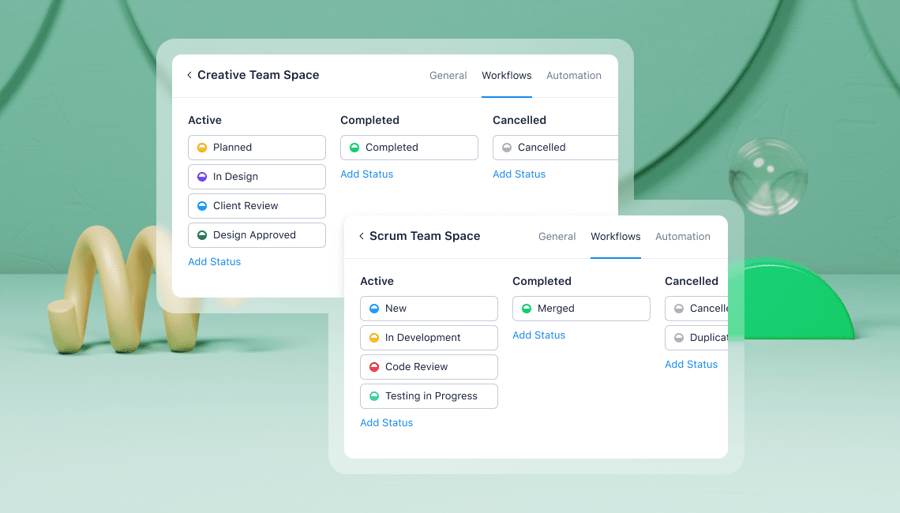Agile release planning is a valuable technique for building customer-centric products and projects. It helps achieve your product roadmap through, planning poker Agile, iterative sprint planning, and daily standup meetings where you review and incorporate feedback to ensure incremental product improvements over time.
Agile release planning is a tactical version of your overall product vision and roadmap. Release plans guide sprints, where product requirements are prioritized, developed, and released. They also provide direction and a clear process to guide the product team while remaining flexible to incorporate customers’ and stakeholders’ feedback.
Note that Agile release planning encourages shipping requirements incrementally instead of pushing multiple changes in one release.
What is an Agile release plan?
What is a release plan? An Agile release plan is a dynamic document that breaks down how and when the organization releases product features or functionalities. This plan prioritizes feedback from previous iterations and sets out the scope, timeline, and resources for each release.
Agile release plans help teams decide how much functionality can be provided and how long it will take to develop. You can think of it as a prioritized list of functionalities to be delivered to the market, for an improved customer experience, over time.
In large, multi-departmental companies, release plans are excellent tools for communicating product status and progress with cross-functional teams, leaders, and stakeholders involved in a project, ensuring clear, aligned expectations for product development.
What to discuss in an Agile release planning meeting
Agile release planning’s main objective is to identify the next batch of minimal market features and establish a release date. Discussions in an Agile release planning meeting must cover:
- Prioritizing features and functionalities for upcoming releases
- Reviewing and incorporating gathered feedback in upcoming sprints
- Articulating clear deliverables that state if the current sprint’s outcome would be a product increment or release
- Deciding which product versions get released to the market and the best order of these releases
Your development team may create versions 1.1, 1.12, 1.13, and 1.2 but only release the primary versions to users. Prioritizing functionalities is crucial, as it is often the case that your team may not tackle all product requirements in one release.
Product and project managers can use the Agile release planning meetings to keep their teams and stakeholders on the same page and generate more buy-in for the product vision.
Who should oversee Agile release plans?
The product owner or project manager oversees Agile release planning and manages the sprint and product backlog to ensure continued alignment with the overall product vision.
It’s important to include essential members of your development team early in the release planning process to leverage their expertise, perspectives, and experience. Without your team’s input, you run the risk of creating a roadblock instead of a roadmap.
What is the purpose of release planning in Agile and Scrum?
The purpose of release planning in Agile and Scrum is to ensure your project moves in the right direction, aligns with the overall product roadmap, and beneficially incorporates feedback.
Agile and Scrum release planning are excellent for managing projects that require rapid development and testing within short periods. They provide an outward perspective for the development team, putting individual sprints in the context of the larger strategic product vision.
Agile and Scrum release planning are also great tools for combining similar requirements for improved customer experience. Commonly used in IT projects, a software release plan is a standard method of managing software development projects.
What is the difference between a release plan and a roadmap?
Product roadmaps and release plans are two related project management tools with distinct product development processes. The product roadmap contains high-level requirements broken up into release plans, while release plans implement the product roadmap derived from the product vision.
A typical Agile framework drills down from product vision to action plans following the steps below:
- Product vision
- Product roadmap
- Release plan
- Sprint plan
- Daily standup
The roadmap is where the product vision meets strategy, and the release plan is where project tasks and release dates are managed and executed. You could say a product roadmap depicts your product’s planned future, and release plans detail how your team intends to achieve the product vision in iterative cycles.
The most crucial step in the Agile release planning is conducting sprint retrospectives. The feedback from the retrospective sessions helps teams improve their processes for future sprints and see better results quickly.
Best practices for Agile release planning
Agile release planning varies between organizations, but the general elements remain the same. If you are working on a software development project, ensure that your software release plan includes:
- Product requirements analysis
- Dates of proposed releases
- Plans for each product or incremental release
- Subsequent iterative cycles for the release
- Plans for each iterative cycle
- Feature or functionality development within an iterative cycle
- Tasks necessary to successfully deliver a feature
- Proofing and approval procedures
Careful planning, combined with an iterative schedule, increases your chances of success. Your release planning system must be nimble to adapt to changes and act on data and feedback. Stay open to reprioritizing project tasks to provide maximum value to your customers.
Other best practices for Agile release planning include:
- Establishing measurable goals that describe the outcomes or benefits your product should create
- Determining the work to be done by getting rough, high-level estimates from your development team
- Estimating the labor cost required by considering your team members’ availability and abilities
- Understanding and working within your constraints, taking note of any hard deadlines or budget limitations
- Monitoring progress from sprint to sprint and making adjustments as needed
- Making data-driven decisions based on actionable feedback
- Setting clear expectations between invested stakeholders and the development team
- Scheduling regular road-mapping sessions as part of your sprint review meetings
- Updating relevant stakeholders
- Ensuring your release plans align with your product roadmap to provide continuity of purpose
- Ensuring that each release builds on the one before
Agile release plan example
Agile release plans are standard in project management teams regardless of the company sector. However, you can find the best Agile release plan examples in the software development industry, where products are typically delivered in versions.
Observe any of your favorite social media apps, for instance. They are constantly adding new features and functionalities based on user feedback and product goals. In 2021 alone, Twitter has announced several incremental changes in its product roadmap, including newsletters, communities, and audio spaces.
While some organizations prefer one-time big releases, others push releases on a steady, periodic basis. Companies can choose to push a release at the end of every sprint or batch them until after a few iterations. You may decide to do it annually, quarterly, monthly, or on an ad hoc basis.
How Wrike can help with your Agile release plan
Wrike helps manage Agile release planning efficiently by serving as a single source of truth and clarity. You can oversee everything from the strategic managerial level to tactical, operational activities like assigning project tasks to team members.
Wrike helps you manage your Agile workflow, prioritize project tasks, track progress, share feedback, and coordinate activities between teams.
Are you ready to achieve long-term product success with your product roadmap tools? Get started with our product mapping and sprint planning templates and a free two-week trial to bring your product vision to life.









